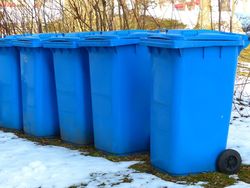
EN 840 vs ANSI Z245.60 - the bitter battle of the MGBs
Everyone knows what a Mobile Garbage Bin is. These humble roadside receptacles go by all manner of names – MGBs, Wheelie Bins, Toters, Roll-out Carts, Trash Cans – but they all look something like this:
Looks, however, can be deceiving. MGBs are designed to be lifted by machines, which means they must comply with a common standard. And since humans never settle on one standard when several will do – there are competing, incompatible standards for MGB design.
Getting the standards mixed up means your new truck, lifter or compactor might not work with your bins. To help avoid that situation, we’ve prepared the following table, with a quick comparison of the two most common MGB standards:
| Specification | EN 840 | ANSI Z245.60 (Type B Containers) |
|---|---|---|
| Standardisation Body | European Committee for Standardisation (CEN) | American National Standards Institute (ANSI) |
| Regional usage | Europe, Asia, Africa, Australia, Oceania | North America, South America |
| Typical capacities | 60-litre, 80-litre, 120-litre, 140-litre, 240-litre, 360-litre | 32-Gal, 48-Gal, 64-Gal, 96-Gal |
| Terminology | Wheelie Bin, Two-wheeled Bin, Mobile Garbage Bin, MGB, Euro-style Bin | Toter, Trash Cart, Two-wheel Cart, Roll-out Cart, Trash Can, Garbage Can, MGB, US-style Bin |
| Bin-hitch mechanism | Hitch attaches to reinforced comb around rim of the bin: |
Hitch attaches to moulded indentation in front face of the bin: |
| Typical wheel position | Wheels outset from body: |
Wheels inline with body: |
| Advantages |
|
|
| Disadvantages |
|
|
| Typical usage | Municipal waste programs; kerbside garbage collection for households and businesses; recycling; green waste; medical waste; shopping malls, apartment blocks and commercial estates. | |
In North America, Simpro equipment is supplied with a standards-based hitch that will safely lift any ANSI Z245.60 (Type B) compliant bin – regardless of shape, size or capacity.

Elsewhere, things are more complicated. The EN 840 standard specifies that lifting equipment should hook into a reinforced comb around the rim of the bin. But this hitch has a hitch: if the bin is too heavy the comb will deform – or tear off completely.
To avoid this, Simpro recommends our unique ‘base-lift’ cradle for EN 840 bins. This proprietary design holds the entire body of the bin, and uses wheel catches to secure it while inverted. The bin is not subject to structural stresses, but must have projecting ‘outset’ wheels.

EN 840 bins with ‘inset’ wheels can only be lifted using the comb as specified in the standard. These means they have a limited weight capacity, and usually wear out faster.
Needless to say: Mobile Garbage Bins might look simple, but there’s more than meets the eye. When you’re investing in waste management equipment, make sure it’s standards-based, and make sure the standards all line up...

After all, no-one likes tipping money into the bin.